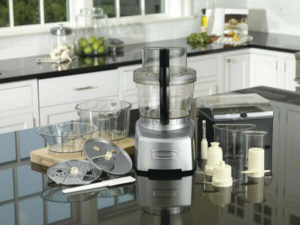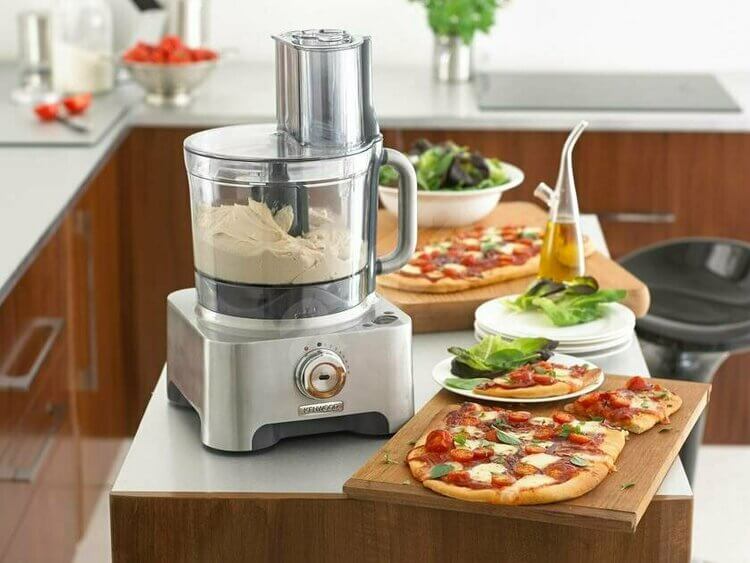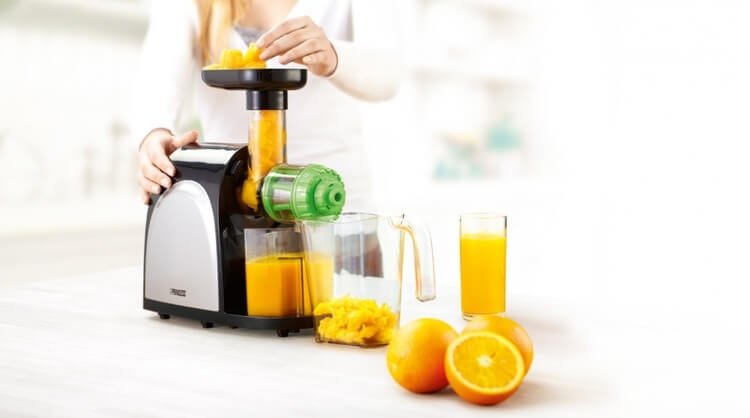What to choose - a blender or a food processor: device specifications and device comparison
 A blender is one of the appliances most commonly found in the kitchen. Such popularity is due to the wide functionality of this device.
A blender is one of the appliances most commonly found in the kitchen. Such popularity is due to the wide functionality of this device.
Its main purpose is to grind solids, but with the help of additional attachments, it can also mix liquids, beat eggs and perform many other operations.
However, the market offers other devices that can do some tasks better than a blender.
Choosing the right instrument ultimately depends on your needs.
Content
Why do you need a blender and what is it like?
The work of the blender is based on the rotation of sharp steel knives. This design makes it easy to grind fruits and vegetables, meat, it can also be used to crack ice, nuts or crackers.
The ability to grind a particular product is primarily determined by the power of the device. It is worth noting that blenders are manual and stationary.
A hand blender consists of a handle with a motor and control buttons, on which a nozzle with metal knives is put on.
When working, such a blender is lowered into a container. The complete set of different models depends on their cost, more expensive devices may have a whisk attachment for whipping liquid and semi-liquid products, as well as a special bowl for chopping solid ingredients.
A stationary blender is a container with a container where rotating steel blades are placed.. To grind food with such a blender, it is necessary to place the necessary components in a bowl, close it with a lid and turn on the device at a certain power.
Of course, the blender has its pros and cons.
pros
- grinding fruits, vegetables, meat, some solid foods;
- high speed of work;
- gives a homogeneous consistency at the output;
- functionality increases with the presence of different attachments.
Minuses
- grinds products not into small slices, but rather into a puree mixture;
- high speed of work causes a rapid overheating of the engine, as a result of which it is often necessary to take a break;
- makes a loud noise.
The versatility of a blender can be very conditional, since additional functions (beating or chopping) do not work as well as when using special separate devices.
Food processor and its functionality
A food processor, as the name suggests, combines many of the most diverse functions needed for cooking. He is able to chop, chop, mix, whip various foods, chop meat, squeeze juice.
Types of combines depend on their functionality. Relatively speaking, a combine can combine such devices: blender + meat grinder, blender + mixer + dough mixer, blender + juicer, etc.
Before choosing a combine, you need to understand well which features are really useful to you and which are not. For quick grinding or mixing of products, you can purchase a compact and relatively inexpensive device.
If you have a large family for which you need to cook a lot and often a variety of dishes, then a massive food processor with many attachments and functions will be an indispensable option..
pros
- easily cope with all the tasks assigned to him;
- thanks to its versatility, it saves money, because it combines a blender, mixer, meat grinder, juicer;
- provides easy and fast processing of a large volume of products.
Minuses
- high price;
- big sizes.
If you compare a combine with a blender, then you need to understand that the blender is designed for grinding and mixing products.. The food processor, thanks to its attachments, can perform much more tasks.
The blender, as a rule, is completed with one (maximum two) bowls and several nozzles. The harvester also has a huge number of bowls, a variety of knives and graters.
There is also a purely visual difference: a food processor is quite large, it needs a lot of space, and a blender can often fit in a small corner or in a drawer (if we talk about a manual model), due to its more compact dimensions.
The cost of the harvester is much higher, as it has a complex design and has many additional nozzles and attachments that expand the versatility of the device.
A simpler blender, respectively, is much cheaper.
Chopper Application
The chopper is a cross between a food processor and the usual manual cutting of products. As a rule, this device consists of a bowl on which a handle is put on top.
Choppers allow you to finely chop both whole foods and large pieces.
Chopped food can be added to a salad, or processed in some other way. Depending on the method of grinding, these devices are divided into choppers and multi-cutters.
The main working element of the chopper is a rotating impeller knife. Such a device is even capable of whipping some liquid products (sauces, pancake dough, creams). The quality of cutting depends on the operating time of the knives, as well as on their location.
With a low placement of the blades, you will get a puree mixture, and with a high placement, a fairly large cut.As a rule, the height of the knives can be adjusted.
A homogeneous composition can only be achieved by grinding products to a puree state.
Multi-cutters have rotating discs, on which a notch of different sizes and shapes is applied..
Such devices can chop and cut products into slices, and the particles will always have the same size.
Whipping or stirring liquid products with the help of multi-cutters will not work. Usually multi-cutters are not equipped with their own bowl, so they are used in their dishes, like a hand blender.
pros
- excellent crushing of solid products (meat, nuts, ice);
- obtaining uniform, well-cut pieces;
- small dimensions of the device.
Minuses
- little functionality;
- heating during prolonged use.
A chopper is in many ways similar to a blender, both in functionality and appearance. It is worth noting that the chopper always has a bowl for chopping food at the bottom, while for a stationary blender it is installed on top..
Using a juicer in the kitchen
Juicers are a completely separate class of devices that differ widely in functionality and purpose. However, in any case, they all serve to perform one task - squeezing juice.
Types of juicers:
- For citrus fruits. Allows you to get juice only from citrus fruits, has a small capacity and compact size.
- Screw. Such a device works on the principle of a press - the product is placed under the auger, which moves and squeezes the juice out of the product by force. This type is the most productive, as it can squeeze the maximum juice out of the pulp.
- Grid or centrifugal. The most common type, the working element of which are rotating knives placed in a container with mesh walls. During operation, the product is crushed and rubbed through the mesh, due to which juice is released, and unnecessary pulp is automatically removed into a special container. The performance of such a juicer depends on its power, the most powerful devices can process hard fruits and vegetables.
The advantages and disadvantages of juicers depend on their type and power. It is worth considering in more detail the differences between a juicer and a blender:
pros
- A juicer allows you to get pure juice without pulp, while a blender makes juice with impurities, which is more like a thin puree.
- The juicer removes the used cake in a separate container, and the blender will leave it with the juice.
- The operating time of juicers is from 5 to 15 minutes. Expensive blenders are able to work until the desired consistency of the product is reached.
- The juicer can even handle hard fruits and vegetables. The blender will simply chop them, or, in extreme cases, turn them into porridge.
- A juicer is used only for making juice, and a blender is suitable for making puree or a variety of fruit cocktails.
Minuses
- no significant deficiencies were identified.
In general, the choice again depends on the needs that arise in the kitchen.. The blender allows you to carry out a variety of operations, but you cannot get juice with it. If the presence of freshly squeezed juice is necessary for you, then in this case you can not do without a high-quality juicer.
Comparison of blender, food processor, juicer and grinder
This table lists the various operations that can (or cannot) be performed by the devices discussed in this article.
It should be noted that the comparison took into account the possibility of expanding the functionality of the device due to additional attachments.. So, for example, a blender can beat eggs if there is a whisk attachment, and a juicer can theoretically be used to grind fruit, although this is not included in its purpose.
| Type of transaction | Blender | harvester | chopper | Juicer |
| Shredding vegetables/fruits | Yes | Yes | Yes | medium |
| Puree preparation | Yes | Yes | medium | No |
| chopping meat | medium | Yes | Yes | No |
| crushing nuts | medium | Yes | Yes | medium |
| ice pick | medium | Yes | Yes | No |
| Cocktail preparation | medium | Yes | No | No |
| Beating whites / yolks / eggs | medium | Yes | No | No |
| Making homemade mayonnaise | No | Yes | No | No |
| Liquid dough for pancakes | medium | Yes | medium | No |
| Thick sour cream dough | medium | Yes | medium | No |
| Dough for baking pies / cheesecakes | No | Yes | No | No |
| juice squeeze | No | Yes | medium | Yes |
| coffee/spice grinder | No | Yes | Yes | No |
| Slicing a specific shape / grater | No | medium | Yes | No |
If you are faced with the question - what to choose, a blender, or some other device - you need to clearly understand what purpose various devices have. The blender is good at grinding and mixing products, in addition, its functionality can be slightly expanded with attachments.
You can’t get juice with a blender, a juicer will do just fine. If you only need grinding, then you should choose a special grinder. The food processor, in turn, will perfectly cope with all of the above tasks..
Useful video
From the video you will learn which is better - a blender or a juicer:







Blender or food processor, that is the question? What to choose? One has to look at the number of people in the family, if a lot better combine. The immersion blender is more mobile and easier to clean. Can be used intermittently in the cooking process, while the combine requires installation and configuration. Ideally, you should have both.
I am an experienced hostess and I cook a lot, including often baking and making juices with pulp in the fall for the winter and often cocktails. I use 3 types of this technique: a food processor, an immersion blender and a small smoothie blender. Of course, most often I use a combine, but other assistants are also in demand, everyone has their own job and it is convenient for me to have 3 types of this equipment.
Of course, every housewife should have a food processor as a priority. At first I bought a good combine, and after a while I bought a blender, and then from the budget positions. I chose the submersible version of the blender, it seemed to me universal due to the fact that I could grind food in a saucepan and in a cup.
I am a mother of 4 children, I have 3 men and a daughter, I spend a lot of time in the kitchen, I use a food processor, he is my biggest helper, chop, grind, knead the dough, he copes with everything!
In my opinion a food processor is better than a blender. It has everything for cooking. But the blender helps out well when you need to quickly mix something for breakfast, for example. I'm on healthy food for the second month. In the morning, raw fruits and vegetables on a diet should be eaten. I quickly mix everything with a blender and breakfast is ready. Convenient and does not take much time, otherwise I'm always in a hurry. And I use the combine before the weekend when I cook for my family.